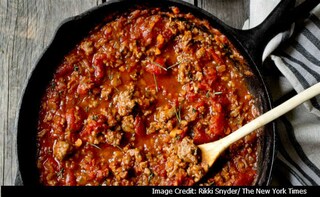When I started out cooking dinner (for my little sister, on the nights my parents went to their weekly disco lesson), meat sauce was one of the recipes I cut my teeth on. (The other was canned-soup stroganoff; we had a great love for ground beef.)
Classic Meat Sauce
Time: About 2 hours
Yield: About 3 cups, enough for 1 to 1 1/2 pounds pastaIngredients1 pound sweet Italian sausage or bulk sausage
Extra-virgin olive oil
1 onion, minced
1 carrot, minced
1 celery stalk, minced
1/4 cup minced flat-leaf parsley, plus extra for garnish
1 28-ounce can whole tomatoes, preferably San Marzano, with its juice
1 large sprig fresh thyme
1 large sprig fresh rosemary
3 tablespoons tomato paste
Salt
Ground black pepper
1 pound tubular dried pasta such as mezzi rigatoni, paccheri or penne
Freshly grated Parmesan cheese, for garnish, optionalPreparation1. With the tip of a small, sharp knife, slit open the sausage casings. Crumble the meat into a wide, heavy skillet or Dutch oven and set over medium-low heat. If the meat is not rendering enough fat to coat the bottom of the pan as it begins to cook, add olive oil one tablespoon at a time until the meat is frying gently, not steaming. Sauté, breaking up any large chunks, until all the meat has turned opaque (do not let it brown), about 5 minutes.2. Add onion, carrot, celery and parsley and stir. Drizzle in more oil if the pan seems dry. Cook over very low heat, stirring often, until the vegetables have melted in the fat and are beginning to caramelize, and the meat is toasty brown. This may take as long as 40 minutes, but be patient: It is essential to the final flavors.3. Add tomatoes and their juice, breaking up the tomatoes with your hands or with the side of a spoon. Bring to a simmer, then add thyme and rosemary and let simmer, uncovered, until thickened and pan is almost dry, 20 to 25 minutes.4. Mix tomato paste with 1 cup hot water. Add to pan, reduce heat to very low, and continue cooking until the ragù is velvety and dark red, and the top glistens with oil, about 10 minutes more. Remove herb sprigs. Sprinkle black pepper over, stir and taste.5. Meanwhile, bring a large pot of salted water to a boil. Boil pasta until just tender. Scoop out 2 cups cooking water, drain pasta and return to pot over low heat. Quickly add a ladleful of ragù, a splash of cooking water, stir well and let cook 1 minute. Taste for doneness. Repeat, adding more cooking water or ragù, or both, until pasta is cooked through and seasoned to your liking.6. Pour hot pasta water into a large serving bowl to heat it. Pour out the water and pour in the pasta. Top with remaining ragù, sprinkle with parsley and serve immediately. Pass grated cheese at the table, if desired.© 2015 The New York Times News Service
Advertisement
Advertisement
Advertisement
Advertisement
Classic Meat Sauce
Time: About 2 hours
Yield: About 3 cups, enough for 1 to 1 1/2 pounds pastaIngredients1 pound sweet Italian sausage or bulk sausage
Extra-virgin olive oil
1 onion, minced
1 carrot, minced
1 celery stalk, minced
1/4 cup minced flat-leaf parsley, plus extra for garnish
1 28-ounce can whole tomatoes, preferably San Marzano, with its juice
1 large sprig fresh thyme
1 large sprig fresh rosemary
3 tablespoons tomato paste
Salt
Ground black pepper
1 pound tubular dried pasta such as mezzi rigatoni, paccheri or penne
Freshly grated Parmesan cheese, for garnish, optionalPreparation1. With the tip of a small, sharp knife, slit open the sausage casings. Crumble the meat into a wide, heavy skillet or Dutch oven and set over medium-low heat. If the meat is not rendering enough fat to coat the bottom of the pan as it begins to cook, add olive oil one tablespoon at a time until the meat is frying gently, not steaming. Sauté, breaking up any large chunks, until all the meat has turned opaque (do not let it brown), about 5 minutes.2. Add onion, carrot, celery and parsley and stir. Drizzle in more oil if the pan seems dry. Cook over very low heat, stirring often, until the vegetables have melted in the fat and are beginning to caramelize, and the meat is toasty brown. This may take as long as 40 minutes, but be patient: It is essential to the final flavors.3. Add tomatoes and their juice, breaking up the tomatoes with your hands or with the side of a spoon. Bring to a simmer, then add thyme and rosemary and let simmer, uncovered, until thickened and pan is almost dry, 20 to 25 minutes.4. Mix tomato paste with 1 cup hot water. Add to pan, reduce heat to very low, and continue cooking until the ragù is velvety and dark red, and the top glistens with oil, about 10 minutes more. Remove herb sprigs. Sprinkle black pepper over, stir and taste.5. Meanwhile, bring a large pot of salted water to a boil. Boil pasta until just tender. Scoop out 2 cups cooking water, drain pasta and return to pot over low heat. Quickly add a ladleful of ragù, a splash of cooking water, stir well and let cook 1 minute. Taste for doneness. Repeat, adding more cooking water or ragù, or both, until pasta is cooked through and seasoned to your liking.6. Pour hot pasta water into a large serving bowl to heat it. Pour out the water and pour in the pasta. Top with remaining ragù, sprinkle with parsley and serve immediately. Pass grated cheese at the table, if desired.© 2015 The New York Times News Service
For the latest food news, health tips and recipes, like us on Facebook or follow us on Twitter and YouTube.
Advertisement
Tags:
